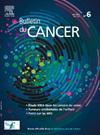Les formes rares de cancer du poumon
IF 1.1
4区 医学
Q4 ONCOLOGY
引用次数: 0
Abstract
En Europe, on définit un cancer rare lorsque son taux d'incidence est de moins de 6/100 000. Les cancers pulmonaires rares regroupent de nombreuses entités définies par la classification de l'Organisation mondialede la santé(OMS) des tumeursthoraciques dont la dernièredate de2021, et représentent environ 10 % des cancers du poumon. Ils concernent plusieurs types histologiques (carcinome, sarcome et lymphome), dont chacun comporte plusieurs entités. La prise en charge des patients atteints de cancer rare nécessite une expertise médicale à chaque niveau (diagnostic, thérapeutique et suivi). Ces patients doivent ainsi être dirigés vers des centres experts rattachés à des réseaux nationaux pour une prise en charge personnalisée et faciliter l'accès à l'innovation. La caractérisation moléculaire systématique de ces tumeurs a permis d'individualiser des entités et de mieux les caractériser. Certaines entités sont spécifiques de la localisation pulmonaire, d'autres peuvent être retrouvées plus fréquemment dans d'autres organes. Dans cette revue, nous traiterons des tumeurs malignes dont l'incidence est inférieure à 1 %.
In Europe, a rare cancer is defined as having an incidence rate of less than 6/100,000. Rare lung cancers encompass many entities defined by the 2021 WHO classification of thoracic tumors, and represent around 10% of all lung cancers. Rare lung cancers involve several histological types (carcinoma, sarcoma and lymphoma), each of which comprises several entities. The management of these patients with rare cancers requires specific medical expertise at every level (diagnosis, treatment and follow-up). These patients should therefore be referred to expert centers affiliated with national networks, giving them appropriate care and better access to innovative treatments. The deployment of systematic molecular characterization of these tumors has allowed for the identification and better characterization of specific entities. Some entities are specific to the lung, while others are more commonly found in other organs. In this review, we will only consider malignant lung tumors with an incidence of less than 1%.
求助全文
约1分钟内获得全文
求助全文
来源期刊

Bulletin Du Cancer
医学-肿瘤学
CiteScore
1.90
自引率
16.70%
发文量
224
审稿时长
37 days
期刊介绍:
Without doubt, the ''Bulletin du Cancer'' is the French language publication of reference in the field of cancerology. Official organ of the French Society of Cancer, this journal covers all the information available, whether in the form of original articles or review articles, but also clinical cases and letters to the editor, including various disciplines as onco-hematology, solids tumors, medical oncology, pharmacology, epidemiology, biology as well as fundamental research in cancerology. The journal proposes a clinical and therapeutic approach of high scientific standard and regular updates in knowledge are thus made possible. Articles can be submitted in French or English.
 求助内容:
求助内容: 应助结果提醒方式:
应助结果提醒方式:


